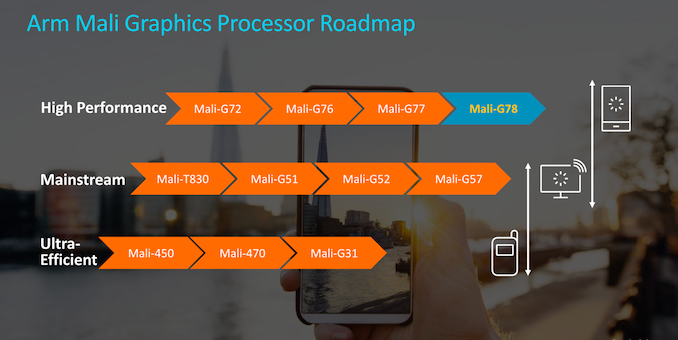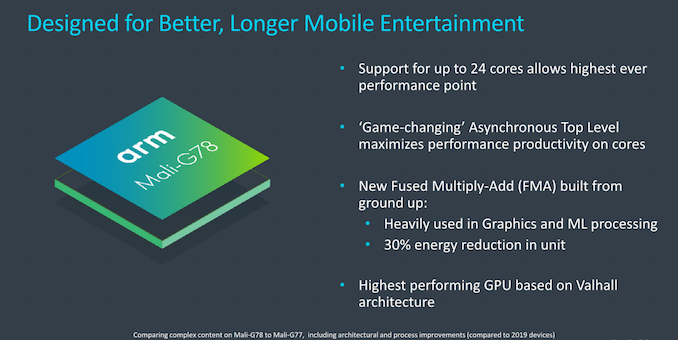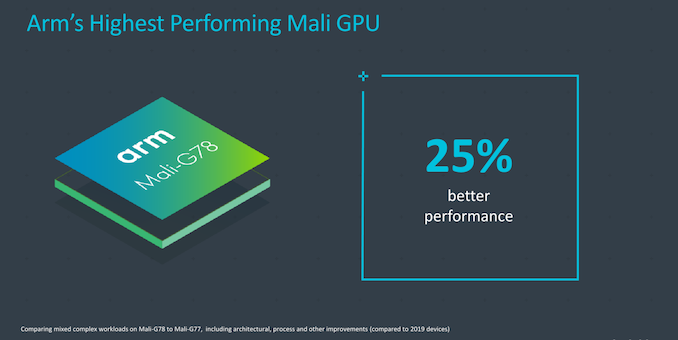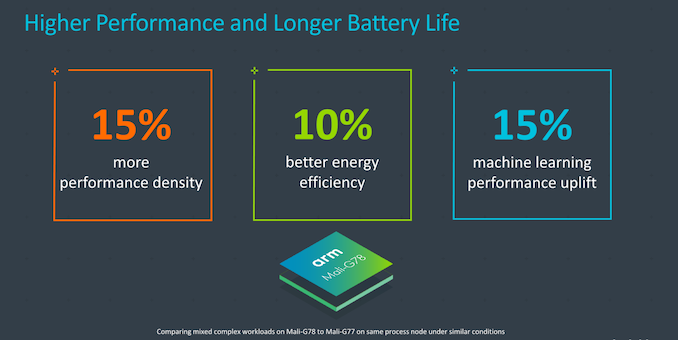Arm Announces The Mali-G78 GPU: Evolution to 24 Cores
by Andrei Frumusanu on May 26, 2020 9:00 AM EST
Today as part of Arm’s 2020 TechDay announcements, alongside the release of the brand-new Cortex-A78 and Cortex-X1 CPUs, Arm is also revealing its brand-new Mali-G78 and Mali-G68 GPU IPs.
Last year, Arm had unveiled the new Mali-G77 which was the company’s newest GPU design based on a brand-new compute architecture called Valhall. The design promised major improvements for the company’s GPU IP, shedding some of the disadvantages of past iterations and adapting the architectures to more modern workloads. It was a big change in the design, with implementations seen in chips such as the Samsung Exynos 990 or the MediaTek Dimensity 1000.
The new Mali-G78 in comparison is more of an iterative update to the microarchitecture, making some key improvements in the matter of scalability of the configuration as well as balance of the design for workloads, up to some more radical changes such as a complete redesign of its FMA units.
On the scalability side, the new Mali-G78 now goes up to 24 cores in an implementation, which is a 50% increase in core count compared to the maximum MP16 configuration of the Mali-G77. To date, the biggest configuration we’ve seen in the wild of the G77 was the M11 setup of the Exynos 990, with MediaTek employing an MP9 setup.
In a projected end-device solution comparison between 2020 and 2021 devices, Arm is projecting the new Mali-G78 to achieve 25% better performance, which includes both microarchitectural as well as process node improvements. That’s generally the reasonable target that vendors are able to achieve on newer generation IPs, but it’s also going to be strongly depending on the exact process node improvements that are projected here – as GPUs generally scale better with improves process density rather than just frequency and power improvements of the silicon.
At an ISO-process node under similar implementation area conditions, the Mali-G78 is claimed to improve performance density by 15%. This is referring to the either performing 15% better at the same area, or shaving off 15% area for the same performance, given that this can be done linearly by just adjusting the amount of GPU cores implemented.
Power efficiency sees a more meagre 10% improvement, which honestly isn’t too fantastic and not that big of a leap to the Mali-G77. ML performance is also said to be improved by 15% thanks to some new microarchitectural tweaks.
Seemingly, the Mali-G78 doesn’t look like too much of an upgrade compared to the vast new redesign we saw last year with the G77 – and in a sense, that does seem somewhat reasonable. Still, the G78 does some interesting changes to its microarchitecture, let’s dwell a bit deeper into what’s changed…














36 Comments
View All Comments
HardwareDufus - Thursday, May 28, 2020 - link
Thank you for taking the time to teach the author by example. Concise vocabulary and brief statements are a must in tech journalism as the subject matter at hand is quite complex.While your intent was good, you might have refrained from using the phrase 'like pulling teeth'. A phrase like that will immediately put people on the defensive, as is evident by several responses to your post.
You write very well and your constructive criticsm and suggestions are helpful. Strive to serve it in a manner where the recipient is more likely to accept. The best way to offer constructive criticism is the 3C rule: Commend, Counsel, Commend.
Oldiewan - Saturday, September 11, 2021 - link
Anal much?Oldiewan - Saturday, September 11, 2021 - link
Reading that was like pulling teeth.brucethemoose - Tuesday, May 26, 2020 - link
TBH, does ARM really need to design a top end GPU?Apple has definitely-not-PowerVR, and Imagination is hungry for any customer they can get. Samsungs going AMD. Broadcomm, Qcom, Nvidia and Hisilicon are all in firmly in house.
That leaves Mediatek and small fish, which is not a very demanding market.
SarahKerrigan - Tuesday, May 26, 2020 - link
Hisilicon uses Mali; they aren't inhouse.brucethemoose - Tuesday, May 26, 2020 - link
Ah, yeah, dont know what I was thiking. And HiSilicon is a big fish.Still, theres more demand from big customers for licensed CPUs than GPUs.
dotjaz - Tuesday, May 26, 2020 - link
True for now, there's no guarantee they won't switch to PowerVR B-series soon given the current political environment causing them being cut off from all other parts of ARM (bar the perpetual architectural-licensing).There's really no economy of scale left once they switch to in-house CPU core inevitably in the next year or two.
s.yu - Sunday, May 31, 2020 - link
In house based on what? RISC-V? Know that if they're banned, they can't license any further updates to ARMv8 either.Kamen Rider Blade - Tuesday, May 26, 2020 - link
Apple has kicked PowerVR to the curb and gone in-house for their GPU's.Samsung says screw it, AMD take over the GPU side.
Qualcomm has their own ADRENO brand that they bought from AMD's Imageon line.
nVIDIA is obviously using their own GPU.
MediaTek switches from Mali to PowerVR depending on product line / generation.
HiSilicon has generally stuck with Mali
Broadcom has their own VideoCore line of GPU's
regsEx - Tuesday, May 26, 2020 - link
Samsung still only uses Mali. AMD is just a rumor so far.